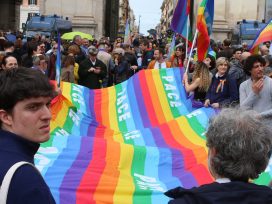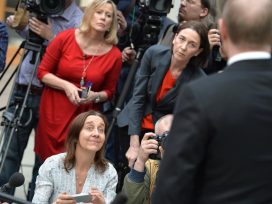Odessa's two big differences (and a few small ones)
Life after the Maidan and 2 May
On 2 May, clashes between anti-Maidan and Euromaidan activists claimed 48 lives in Odessa. The city is still in shock. Tanya Richardson reports on how Russian intervention in Crimea has made such questions as “Who am I?” and, “In which state will I be secure?” more pressing than ever.
My Odessan lunch did not happen this year. Most of my trips to Odessa over the last decade have included a shared meal at the home of my friends Alexandra and Vitaliy with Boris and Yuriy, lunches that almost always included Alexandra’s exquisite eggplant caviar. The men – Odessan Jews – would trade jokes, stories and memories, and reflect on the disappearance of the city of their youth. Periodically, they would pause to explain the nuances of an Odessan turn of phrase. Yuriy would describe his small publishing company’s latest book project on Odessan architecture. Boris, a retired engineer and photographer, would present a new collection of images. He had given up photographing streetscapes because they had been spoiled for him by the proliferation of advertising and SUVs obscuring building facades. But Odessan faces still spoke to him. He had a special affection for Vitaliy and Yuriy and would delight in describing their physiognomy to me. Occasionally talk would turn to Ukrainian politics. However, Alexandra – a lawyer and fifth generation Odessan of mixed Polish, German, Russian and Ukrainian ancestry – would nip these discussions in the bud, knowing the impossibility of reconciling Boris’ communist views and the others’ support for Ukraine’s European path.
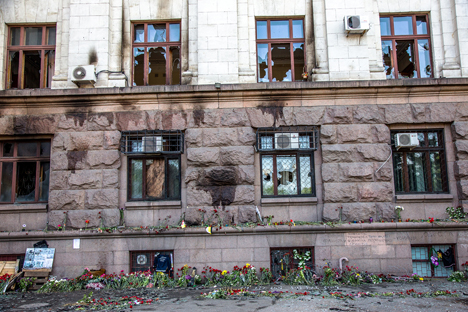
The burning of the House of Trade Unions in Odessa, Ukraine on 2 May 2014. Photo: A_Lesik. Source:Shutterstock
We did not gather this year because Boris had severed ties with Alexandra and Vitaliy after learning that they had joined several thousand Odessans in a 2 March demonstration against Russian intervention in Crimea. Boris had written Vitaliy that he was, in fact, a Ukrainian patriot. However, the country’s government, in his view, had been taken over by fascists, descendants of people who had murdered his relatives in western Ukraine during the Holocaust. For that reason, southern and eastern oblasts should break away as quickly as they could. For Alexandra, Vitaliy and Yuriy, in contrast, it was Putin’s Russia that represented a fascist threat. Outraged at plans to foment separatism in the south and east and disturbed by the fabrications and inflammatory language in Russian media, Alexandra and Vitaliy had plastered anti-Putin posters around the city. Meanwhile, fear that Odessa would become part of Russia had caused the normally jovial, easy-going Yuriy to lose a tremendous amount of weight and to display such ferocity in defending Ukraine that he surprised his long-time friend Vitaliy. Yuriy explained: “They [his unspecified antagonists] think I am a fascist. I think they are fascists. It’s enough to lose your mind.” Alexandra and Vitaliy were concerned that he might.
My friends felt that most of their fellow Odessans had been largely disengaged from the events occurring on Kyiv’s Independence Square prior to the toppling of president Viktor Yanukovich on 22 February, even though they may have worried about them. To be sure, Odessan Euromaidan activists began gathering at the Pushkin monument near City Hall on 22 November, one day after Kyiv activists’ first meeting.1 They then shifted to the monument of the Duc de Richelieu at the top of the famous Odessan steps.2 Three Odessan activists had the dubious distinction of being detained by militia on 25 November (one of them was beaten), days before the first attacks on participants in the Kyiv Euromaidan.3 An “Odessan Euromaidan anthem” produced by some of the city’s renowned comedians (and featuring the Richelieu monument) circulated widely on social media networks.4 So too did a demonstration called “Zapadentsy march” (westerners’ march) with its posters featuring nineteenth-century western Europeans who had helped establish Odessa.5 This slogan gave zapadentsy – a pejorative Soviet-era Russian term for western Ukrainians that casts them as radical nationalists – a new, positive valence. Odessans’ appropriation of the term had a dual meaning, emphasizing both the city’s historical connections to western Europe and the hopes many residents shared with western Ukrainians for a common European future. In late January, the pro-Russian groups Molodezhnoe edinstvo (Youthful Unity) and Narodnoe alternativa (Popular Alternative) began organizing an anti-Maidan movement and self-defence units called druzhiny, with the explicitly stated goal of opposing fascists.6
Odessan cultural theorist Mark Naidorf argues that it was Yanukovich’s flight, the appointment of an interim government, and the Russian intervention in Crimea at the end of February 2014 that turned the Kyiv crisis into a truly national one.7 Like other Ukrainian citizens across the south and east, Odessans were forced to face existential and political questions like “Who am I?” and “In which state will I be secure?” Fears provoked by the thought of living under one government or another crystallized national identities and motivated thousands of normally apolitical citizens to join demonstrations. Commentators grasped for labels to depict the two camps: “pro-Ukrainian” vs. “pro-Russian”, “Euromaidan” (or just Maidan) vs. “anti-Maidan”, and the less common “unitarists” (for a unitary state) and “federalists”. These labels only partially captured supporters’ rapidly changing motivations and agendas. The movements were ever-evolving assemblages of self-defence brigades, party activists, politicians and social media pages, along with online, print and TV media outlets, and more and less formal groupings of citizens. Each had its slogans: “Odessa is Ukraine”, “No war in Ukraine”, “Hands off Ukraine” on the one hand, and “Putin save us!” “Russia, help!” “Odessa is a Russian (russkiy) city” on the other, to name just a few. The Euromaidan activists set up checkpoints to thwart separatists in an attempt to compensate for a state apparatus in disarray. The anti-Maidan built a tent city on Kulikovo Field in front of the Trade Union building. The political demands of the two camps morphed alongside the changing political situation. As March and April progressed, it seemed to some observers that the radicals in each movement had gained the upper hand.
Tensions came to a violent climax in the 2 May confrontation that killed 48 people, most of them anti-Maidan supporters, and injured hundreds of others. The violence erupted when Kulikovo Field activists came to the city centre to block a march that Kharkiv and Odessan football fans had planned in support of Ukrainian unity. The anti-Maidan activists thought that the football fans intended to clear their tent city because the governor had announced his plan to do so (though he did not specify a date or who would do it). These activists’ act of confronting the football fans quickly turned violent. During the first hour, activists on both sides threw smoke grenades and broken tiles. Then freshly arrived Kulikovo Field activists, shielded by police, fired on Euromaidan activists, causing the first death. After further clashes resulted in more deaths and serious injuries, football fans and some Euromaidan activists issued a call for Kulikovo Field to be cleared. Prior to the fans’ arrival, anti-maidan activists called on their supporters to take cover in the Trade Union building. A few hundred people entered. When the Euromaidan supporters reached Kulikovo Field they set fire to tents. More shots were fired. Molotov cocktails were thrown from inside and outside the Trade Union building. More shots were fired. The building caught fire. Fire fighting trucks arrived late. Most of the deaths occurred as a result of the fire. It is difficult to overestimate the shock this has been for Odessans.8
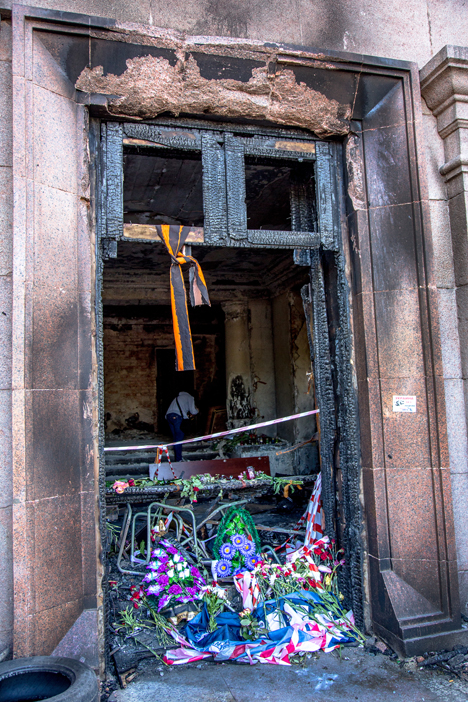
Flowers in memory of those who died in the House of Trade Unions. Photo: A_Lesik. Source:Shutterstock
In late May, I visited Odessa for the first time since the fall of Yanukovich. Directly experiencing the depth of the schism in the city led me to think of Isaac Babel, the difficult-to-categorize Soviet Jewish writer who was one of the city’s great mythmakers. What came to mind was not Babel’s clever, witty Jewish bandits, but his famous observation in his text “Odessa” that residents of this Black Sea port say “two big differences”.9 Odessans might say, for example, “Kyiv and Odessa are two big differences” instead of the standard “there’s a big difference between Kyiv and Odessa”. According to literary scholar Rebecca Stanton, this phrase recognizes the basic truth that “it takes two to differ”.10 It also condenses, she argues, an ability displayed by Odessan modernist writers like Babel (and presumably other Odessans) to embody irreconcilable differences and to see from different points of view simultaneously. It is one feature of the Odessa myth, an evolving persuasive story that claims Odessan uniqueness is connected to (among other things) its history as part of the Russian Empire, its mixed, multi-ethnic population, its ethos of trade and business and an ironic stance vis-à-vis any ruling power.11
Inhabiting irreconcilable perspectives in real life is a tricky business. Perhaps it’s not surprising that Odessa enthusiasts dream of the return of free port status. Such a move would enable Odessa to exist as a semi-sovereign city-state subordinated neither to Kyiv nor to Moscow – neither of which, Odessans will tell you, ever really looked favourably on this irreverent, entrepreneurial city. This would enable Odessans to sidestep the issue of choosing which state or nation they should belong to. But the political polarization that produced the 2 May violence has confronted citizens with the limits of the Odessa myth. Oksana Dovgopolova, a philosophy professor, put it in even stronger terms: “What happened destroyed our myth. We have to build a new Odessa.”12 It turns out that Odessans aren’t always as tolerant, ironic or witty as they thought. Try as they might, they cannot remain aloof from national and international politics.
Some Odessans shocked at the violence of 2 May were quick to blame outsiders for the city’s troubles. Early media reports about 2 May claimed that it was fighters from Prydnistrovia and Russia who were responsible and who perished in the Trade Union building. Meanwhile, some argue that Maidan supporters are “not Odessan”; they are either political tourists or recent migrants who do not understand the Odessan way of life. Each side had its own version of which external actors were the tragedy’s instigators. Boris Khersonskiy, a renowned Odessan psychiatrist and poet, captured this in a Facebook post on 7 May: “Diagnosis: split past.” Elaborating, he wrote,
No matter what conclusions international experts might draw about the events of 2 May, there are two versions that will remain in people’s consciousness:
a) Bandery [radical Ukrainian nationalists] turned Odessa into a new Khatyn [name of an area of Belarus where Germans shot villagers and that was made into a Soviet War monument].
b) The Russian Federal Security Service and Russian Military Intelligence organized a huge provocation in the interests of Russian imperialism.
However, other observers reject attempts to lay all blame on outsiders. Referring to this tendency, my friend and museum employee recalled the numerous anti-Jewish pogroms, the first of which took place just a quarter century after the city’s founding in 1794, and the 25,000 Jews burnt in a warehouse on the city’s outskirts during the Romanian Occupation in 1941. While more sympathetic to the pro-Ukraine movement, he also rejected both sides’ black and white portrayals of who is innocent and who is a victim. Using the example of the Maidan activists he said, “Odessa is people who saved those trying to escape from the fire. And Odessa is people who beat people after they jumped from the burning building.” He also feared that perpetrators would remain unpunished, just as they had in the past. For him, prosecuting individuals on both sides who carried out violent acts and those who choreographed them are the most important steps the authorities could take to secure peace. While some senior state officials had been replaced, most of the rank and file of the corrupt state apparatus remained in their positions.13
Odessa’s “two big differences” figured prominently in almost all of my encounters. Yet, two big differences break down into many more small differences if you retreat from the front lines and linger in conversation. Many leaders of Odessa’s anti-Maidan movement were open in their desire for Russian intervention and their support for Putin’s New Russia project. They wanted to hold a referendum on secession like the ones in Lugansk and Donetsk. However, not all anti-Maidan sympathizers shared these positions. For example, a friend’s Jewish son-in-law in his 30s attended Kulikovo Field meetings in the hope that it would give rise to a new left movement that focused on issues of social equality and de-emphasized issues of ethnicity. His support dwindled as the prominence of Russian nationalist rhetoric and the Orthodox Church grew. A conversation in a friend’s kitchen with a Ukrainian engineer in his 50s highlighted other issues. He questioned the legitimacy of the government and rejected revolution as a means of seizing power. He said Yanukovich had been correct not to sign the agreement with the EU because of the negative impact it would have had on important sectors of the economy. At the same time, he said he didn’t feel a strong connection to Ukraine as a country: “My country is the Soviet Union.” His son, however, strongly identified with Ukraine and wanted to join the army and fight in the Donbass. One finds analogous diversity in the Maidan camp, where liberal views butt up against the far-right ideologies of the Svoboda party and the Right Sector. Summing up Odessan-style: depending on your point of view, there may be two big differences or many.
Humour is Odessans’ preferred way of managing social tensions in ordinary times. While Odessans have not stopped telling jokes, (though according to Khersonskiy, the jokes have become much darker14), silence and avoidance have become prominent strategies for managing relationships in a time of political conflict. Boris cut his ties with Alexandra and Vitaliy with an email. Nearly everyone has a story about defriending on social media. Others have had terrible verbal arguments. But political opponents are often colleagues or co-resident family members. Many try to avoid political talk in order to coexist or get on with business. A sign on a firm’s door reads, “This office is outside of politics.” However, the moral dilemmas and anguish of remaining silent can also be distressing. A university lecturer sympathetic to the anti-Maidan movement described the acute discomfort he felt when he recognized students who had thrown Molotov cocktails at the Trade Union building where a friend’s son perished. Moreover, silence could not always be maintained. Yuriy and his assistant normally avoided talk of politics, but a heated argument erupted between them when I visited his apartment to interview his girlfriend. I watched in dismay as they hurled insults and accusations at one another, their bodies and faces clenched with anger.
Some Odessans have begun experimenting with alternatives to uncivil speech and silence. Inna Tereshchenko, a political scientist, professional mediator and founder of the Odessa Oblast Mediation Group, has started several formal dialogue initiatives aimed at creating environments for opposing sides to talk. “We all have to live in one city”, she said, a refrain I heard from other Odessans. “The Odessan myth that we all lived together peacefully and prefer to make agreements rather than fight can serve as a tool in this process.” The organization’s first event, a screening of a documentary film about Kosovo with the film’s Norwegian director, produced a change in some activists and a readiness to try a different form of engagement. Inna’s organization has run training in mediation for mixed groups of activists. She also began facilitating weekly meetings for members of opposing sides to talk. This involved curtailing the (still) widespread use of dehumanizing language such as “Ukrop” (dill weed) or “Maidanuty” (Maidan-fucks) to designate Maidan activists, and “Colorado” (potato-eating beetles) or “vatniki” (padded jackets) to designate anti-Maidan supporters. Activists agreed on language for naming people and events that would not immediately offend their opponents. They settled on using place names to designate the camps: “Duke people” for the Maidan and “Kulikovo Field people” for the anti-Maidan. Some learned to speak to opponents without trying to change their opponents’ minds. Maidan activists agreed to stop undertaking certain actions perceived as provocative by their opponents, although they later reneged on some of these agreements. An expert group made up of lecturers from different institutions and of different political persuasions met weekly to discuss colleagues’ analyses of the situation. On the one hand, Inna advocated for the continued existence of “two big differences” in a political atmosphere in which opposition was increasingly becoming equated with being a traitor. On the other hand, she was creating an environment conducive to the multiplication of differences that could help mute the polarization. She admitted that as conflict in Donetsk and Lugansk escalated, her delicate balancing act became more and more difficult.
A screenplay writer and ex-journalist pondered the limits of political pluralism in the face of serious security threats as we strolled through Odessa on 5 June. I had met Anna Kerpel several months after the Orange Revolution to probe the fate of “Odessan tolerance” during that period.15 Relationships had been strained to breaking point but violence had been avoided. Reflecting on the current situation, Anna felt that Odessa would remain peaceful and tension would subside if deliberate destabilization attempts were avoided. She had used her usual journalistic method of measuring the city’s mood by listening to conversations in hair salons, public transport and at Odessa’s Starokonnyi Market, a large flea market in the district of Moldovanka where Anna grew up and lives. Within two weeks, discussion of the 2 May events had subsided at the market. People had moved on to discussing the presidential elections and the armed conflict in the Donbass. By contrast, she said, the killing of a vendor by a drunk driver who avoided charges the previous autumn remained a topic of conversation for much longer.
Anna was not entirely confident, however, that there would be no attempts to stir things up. She did not have any romantic notions about the famed “Odessan tolerance” and instead saw residents’ mythologized view of their city as the effect of their capacity to forget and move on. She recalled how her great-grandmother had been denounced to the Romanian police by a neighbour and killed with an axe. Turning to the contemporary situation, she said, “As a Jew I realize the most important thing is not to allow an occupation to happen.” She had donated money to the army and said she would enlist if she were not the sole breadwinner in her family or responsible for elderly parents. After all, she said, her grandfathers had fought in World War I and the Civil War and her father and uncle in World War II. She recalled their accounts of the effectiveness of force in restoring order in a post-war Odessa faced with rampant banditry, and considered the degree of force that would be prudent in dealing with separatists in the current situation. In the tone of a doctor giving a diagnosis, she foresaw a growing militarization of Ukrainian society and a rise in the pitch of patriotic rhetoric. She was concerned at how little the government seemed to be doing to educate citizens on how to spot individuals planning terrorist attacks and what to do in the event of one.
***
On 11 July, I received news that an Odessan friend had died. He shot himself. I had known him for 14 years. He was a journalist and youth worker and had helped me enormously with my research on Odessa. When I met him in mid-June, he had just learned he likely had a terminal illness. He was blunt with me, as he often was, in saying the meeting would likely be our last. A mutual friend wrote me that he did not have the strength or desire to fight the illness, and that the military conflict in eastern Ukraine and in Israel-Palestine played a part too. He was Jewish and pro-Russian.
The aggression he witnessed in supporters of both the Maidan and anti-Maidan had deeply disturbed him. Yet his kitchen was a rare milieu where friends and neighbours with radically different political preferences would eat and drink at the same table, a practice many others in the city had abandoned (although there were occasions when he shut the discussion down because talk became uncivil). Perhaps it’s not surprising considering that he ran a club for youth from neo-Nazi, Tolkienist, hacker and other subcultures, the aim of which was to “socialize” marginal youth by creating a loosely structured space for conversation. He told me with some pride that none of the neo-Nazis he worked with had continued their commitment to radical right ideologies and none had been involved in the violence in Odessa. He did not think the schism in the city was as clear-cut as some were painting it but he was not optimistic about interventions he or others might make. Although moderates might speak, the response of radicals, he said, was to take up arms, evidence for which he saw in the rising price of weapons on the city’s black market.
***
“Leave room in your future for your opponent.” This was one of the key recommendations on how to avoid further bloodshed that Mark Naidorf made to the expert group mentioned earlier. Listening to anti-Maidan colleagues and friends tamed some of my own pro-Ukraine and pro-Maidan sentiments and forced me to consider how opponents would perceive particular statements or actions. You would think that as an anthropologist I wouldn’t need to be reminded of this, but it turns out I did. My visit made me think about how deep political disagreement can be expressed and engaged rather than dismissed or denounced in Odessa and in Ukraine. As my museum-employee friend put it: “if you corner people and give them no outlet, they will leave or they will take up arms.”
The challenge is how to do this during a conflict that is part civil war and part war with a powerful, aggressive neighbour. As civilian and military casualties have risen, tolerance for political opponents has dissipated. In July, some Odessan Maidan activists removed the memorial to 2 May victims near the Trade Union building. Patriotic crowds have gathered a couple of times around people with St. George ribbons and demanded that law enforcement officials intervene to deal with “separatists” and “traitors”. Meanwhile, force is a language also employed by anti-government groups: a bomb was detonated at the military recruitment office and fires were set at two branches of PrivatBank owned by pro-Ukraine oligarch Ihor Kolomoskiy. Inna confirmed the radicalization of pro- and anti-government groups in her statement at the Odessa Crisis Media Centre. When she condemned the memorial’s removal she was practically accused of defending a fifth column.
Maybe it is naive to expect anything else. But not all Odessans are content to go along with the reduction of many differences to two big ones, or two big differences to one. Inna pries open spaces for political opponents to engage even though it means becoming the object of harsh criticism herself. So too, in a way, did my friend who shot himself. They kept alive the potential in Odessans’ phrase “two big differences” and refused to revert to the standard Russian (or Ukrainian) version. I wonder if my friend’s suicide was also a kind of refusal of this kind of closure. I hope, in any case, that Odessa’s “two big differences” might serve as a reminder of the benefits of (even temporarily) pausing to view the world from a different perspective. Just maybe the experience will lend itself to a joke, to laughter and an agreement to go to the beach instead of going to war.
"The Odessa Euromaidan: Romantics held a meeting on Dumskaia Square", 22 November 2014, dumskaya.net/news/fotorep-s-evromajdana-030918/
"The Odessa Euromaidan: Flying boots, cheerful police and warm conversation", 23 November 2014, dumskaya.net/news/odesskij-evromajdan-den-vtoroj-030937/
Police also seized tents while organizers were packing up after a court banned public meetings until 31 December. See "Organizers of the Odessa Euromaidan released", 25 November 2014, dumskaya.net/news/organizatorov-odesskogo-evromajdana-osvobodili-030983/ and "Court bans Odessan Euromaidan and Catholic Christmas", 25 November 2014, dumskaya.net/news/odesskaya-miliciya-obvinila-lidera-odesskogo-evr-030963/
See youtu.be/De2mU1gJeyU.
"Odessans assured us that the City was founded by Zapadentsy", 10 February 2014, www.048.ua/article/471309
"Odessans can sign up for self-defense brigades by telephone", 25 January 2014, timer.od.ua/news/odessiti_mogut_zapisat_sya_v_otryadi_samooboroni_po_telefonu_869.html
"The sociocultural dimension of the post-Maidan crisis, or, in search of mutual understanding", Mark Naidorf, 4 June 2014, sites.google.com/site/marknaydorftexts/kulturologiceskij-analiz/postmaidan-crisis
The complete lack of trust in the authorities' ability and willingness to conduct a full investigation led to the formation of the "May 2 group". It is comprised of journalists from both pro- and anti-Maidan camps and some specialists. An English language summary of their work can be found here: khpg.org.ua/en/index.php?id=1407453894. A record of their work is available in Russian on their blog: 2maygroup.blogspot.ca/2014/08/2_8.html. See also "May 2 group: Detailed chronology of events in the centre of the city", 26 June 2014 dumskaya.net/news/_7377-037031/ and "Myths of Kulikovo Field Part I", 1 July 2014, dumskaya.net/news/tajny-kulikova-polya-pod-ohranoj-drakona-pravosu-037164/ and "May 2 group: Myths of Kulikovo Field part II" July 9, 2014 dumskaya.net/article/mify-kulikova-polya-chast-vtoraya/. For a narrative of what was known a month after the events see the following, on a news site supporter of Kulikovo Field agendas: timer.od.ua/statji/mesyats_spustya_posle_tragedii_chto_mi_znaem_i_chego_ne_znaem_o_mayskoy_boyne_964.html.
Nathalie Babel, The Complete Works of Isaac Babel, Norton, 2002
Rebecca Stanton, Isaac Babel and the Self-Invention of Odessan Modernism, Northwestern University Press, 2012
Oleg Gubar and Patricia Herlihy, "The Persuasive Power of the Odessa Myth", in Cities After the Fall of Communism: Reshaping Cultural Landscapes and European Identity, eds. J. Czaplicka, N. Gelazis and B. Ruble, Johns Hopkins University Press, 2009; Jarrod Tanny, City of Rogues and Schnorrers: Russia's Jews and the Myth of Old Odessa, Indiana University press, 2011
Yuriy Tkachev, "The May 2 Tragedy: A Crime Without Punishment?" 2 August 2014, timer.od.ua/statji/tragediya_2_maya_prestuplenie_bez_nakazaniya_740.html
Tanya Richardson, "Living cosmopolitanism? 'Tolerance', religion and local identity in Odessa", in The Postsocialist Religious Question: Faith and Power in Central Asia and East-Central Europe, ed. Chris Hann, Lit, 2006
Published 1 September 2014
Original in English
First published by Transit 45 (2014) (German version); Eurozine (English version);
Contributed by Transit © Tanya Richardson / IWM / Eurozine
PDF/PRINTNewsletter
Subscribe to know what’s worth thinking about.
Related Articles
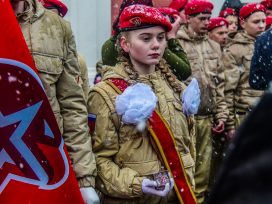
Intellectual violence
The militarization of education in Russia
Education has become another battleground in the Kremlin’s campaign to militarize the Russian public consciousness. Youth organizations, book bans, changes to school curricula – all amount to a ‘special anthropological operation’.
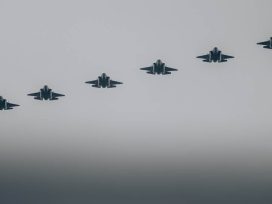
Russian drones entering Polish airspace, militarily seen as intensified provocation rather than open warfare, have nevertheless provoked costly responses – both from NATO’s air defence systems and civilian reactions to disinformation. A war correspondent’s view of what can be done technologically – for greater military efficiency and improved civil defence.



